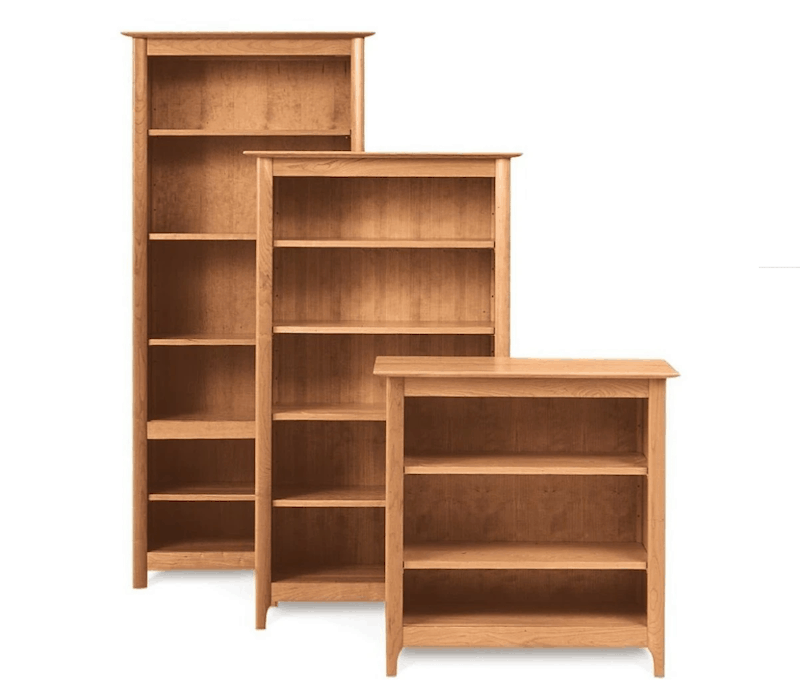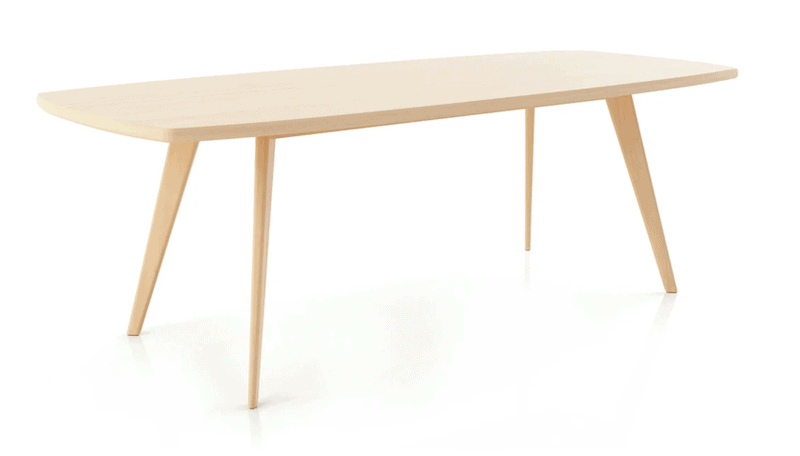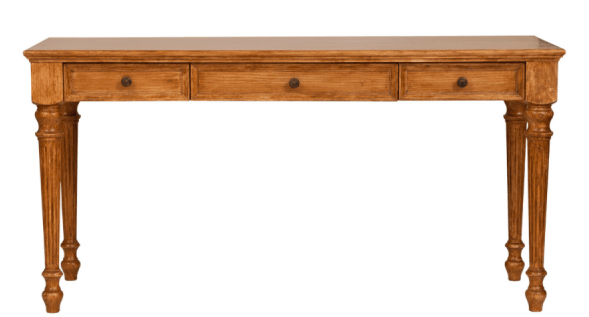This is a look into non-toxic furniture, starting with specialty brands – those are mostly high-quality solid wood options with zero-VOC finishes.
Then on to simple and affordable furniture made of non-toxic materials like glass, hard plastic, metal, and seagrass.
This post was originally written for those with chemical sensitivity (MCS) as well as those very sensitive to dust and mold.
This article contains affiliate links, upon purchase I make a small commission at no extra cost to you.
Tables, Chairs, Bookcases, and Storage
For non-toxic chairs, bookcases, benches, and storage units look for solid wood (with zero-VOC stains and varnishes), and zero or low-VOC adhesives.
Low-odor woods are preferable for some sensitive people.
Avoid particleboard and MDF if you are sensitive to formaldehyde. HDF is another pressed wood product made with formaldehyde which can be found as the backing of many boocases and storage units. Plywood is not as high in offgassing as MDF or particleboard and can work for many sensitive people.
There are some formaldehyde-free engineered wood products like Purebond plywood (though some sensitive folks react to their soy glue).
Some types of furniture are more likely to have a veneer of real wood glued onto a lower-quality wood. In some styles, this is hard to avoid. Laminate or melamine furniture has particleboard inside.

Medley – Has some beautiful solid wood furniture, sealed with WoodShield and made with zero-VOC glues. It’s a favorite brand amongst the chemically sensitive.
Urban Natural – Many lines use either natural oils and a beeswax finish or a zero-VOC water-based catalyzed varnish finish. The glues vary by manufacturer. One brand uses a Cradle-to-Cradle certified (toxicity level yellow) glue.
Viesso – Some lines use ECOS 0-VOC finishes (which are very well tolerated by the chemically sensitive) or natural oil and wax finishes on wooden furniture.

Amazon has a good selection of solid wood-framed chairs.

West Elm also has nice solid wood chairs (dining room).
Simple non-toxic side tables can be found on Amazon. I like this little metal one.

Non-Toxic Vintage Furniture
Vintage or second-hand wooden furniture might be safe and healthy if you are sure it hasn’t been refinished recently with conventional products, and it has not been exposed to chemical cleaning products, air fresheners, smoke, mold, pesticides, or other chemical substances.
With upholstered items, take extra care to make sure it wasn’t from a time frame when flame retardants were used and were toxic. The post on flame retardants goes into more detail.
Those with chemical and mold sensitivities are often on a budget so going with some second furniture or even free furniture is usually worth trying.
Solid Wood Amish Furniture
If you can’t find what you are looking for in the eco stores or in big box stores, try Amish furniture-making companies. They build solid wood furniture.
They often use linseed oil as a finish but unfinished pieces can usually be requested.
Non-Toxic Desks

Vermont Woods makes solid wood desks with a very low-VOC lacquer.
Uplift makes standing desks with solid wood and very low-VOC finishes.
Solid wood desks from specialty stores tend to be pricey.
A dedicated post on non-toxic desks (and desk chairs) can be found here!
On Amazon, you can find simple solid wood desks, like this sturdy solid wood sawhorse-style desk.

You can also find glass and metal desks on Amazon.
Bedroom Furniture
Green Cradle – This company makes 100% solid wood bedroom furniture, either unfinished or finished with linseed oil. They have dressers, chests, armoires, bookcases, nightstands and cribs.
Romina Furniture – Makes furniture for the bedroom for babies, kids, and teens. They use solid wood only, organic natural glues, and a variety of non-toxic finishes.
Baby Eco Trends – Makes furniture for babies and children. Solid wood, Amish made, with a choice of finishes.
Medley – Makes bedroom furniture out of solid wood and bamboo, with all-natural finishes.
Zin Home – Makes bedroom furniture, much of it out of reclaimed wood, and some with natural finishes. They were not able to tell me what all the finishes were, as the items are made overseas.
Vermont Woods – Solid wood bedroom furniture (some pieces have veneer), with very low-VOC lacquer.
TY Furniture – A focus on non-toxic furniture, this company uses solid woods, non-toxic natural oils, and wax finishes with non-toxic glues.
Alternatives to Wooden Furniture
Solid wood furniture from specialty stores tends to be expensive.
These alternatives would also suit those who don’t do well with the odor of wood or have severe allergies and reactions to mold, dust, and allergens.
Non-porous, low-toxin furniture that can easily be wiped down with a variety of cleaning products is a huge advantage for many.
Many of these options are also less expensive which is well suited to those starting over after a moldy or toxic house.
Glass, Metal, Stone & Plastic Furniture
Metal Furniture
Metal is one of the safest materials. Metal may need to be washed down in order to remove factory oils, but otherwise, most finishes don’t offgas.
Powder-coated metal is the safest painted-look finish. Electroplated finishes are totally safe, along with metals that don’t require any finish like chrome and stainless steel. Metal finishes, even if they used a paint, usually cure quite quickly.
Bertoia-style metal chairs, pictured, are popular. There are many metal chairs on Amazon that are very affordable.

Other furniture items you can find in metal are cabinets, drawers, even a chest of drawers though there are some wood products in there, shelves, tables of all sizes, kitchen prep islands, desks, bed frames, TV stands, and more.
I really like this metal console table storage unit.

Glass Furniture
Glass is the most inert material for furniture. It will most often be coupled with metal like this glass and metal coffee table, black glass and metal desk, and this bar cart.
It’s possible to find pieces that are pure glass, like this table from Amazon (pictured) which is surprisingly affordable for a glass product.
There are more glass desk options in the article on desks.

Hard Plastic Furniture
Hard plastics are generally safe and are tolerable for most sensitive people. Almost all furniture made of hard plastic will be a low or no offgassing plastic like polypropylene. Sometimes it needs a couple of days to air out.
I have seen many of these mid-century style chairs in person and they were very inert. Some have metal legs if you want to avoid all wood.

Hard polypropylene, ABX, and acrylic are all highly tolerable, low to no offgassing plastics.
These polypropylene shelves/organizers pictured below could look cool (they come in metal as well).

You can also find many items made of clear acrylic like this really neat trunk, coffee tables, side tables, shelves, and other unique storage units on Amazon.

Sterilite is a plastic that even the very chemically sensitive usually do well with (a mix of polypropylene and polyethylene). You can find drawers made of Sterilite.

Outdoor faux rattan is usually made of safer plastics (like polypropylene) that will work for most folks who are sensitive to chemicals.
Make sure it’s not made of PVC which I have come across (rarely) with outdoor wicker, this does usually offgass. The one pictured could even be used indoors in a beachy-style home.

Stone Furniture
Marble and other stones can be made into tabletops. Marble is made with a resin used to fill in the fissures, and a sealer would also be applied to furniture. You will have to reseal it if it gets heavy use.
Faux marble is most often laminate (with particleboard) – not ideal for the chemically sensitive. Though it could also be a safe hard plastic, or a less safe hard plastic (like cultured marble). It could also be engineered stone which is usually zero-VOC. Be sure to check out what it is made of.
This faux marble island is quartz, which is safe and zero-VOC (but like marble, not cheap).
Rattan, Seagrass, & Banana Leaf Furniture
You might also want to consider furniture made of natural fibers: rattan (a vine), banana leaves (the leaves from banana trees), seagrass (a reed), and bamboo (a grass).
The outdoor “rattan” is usually plastic woven in a wicker style, and works best for outdoor furniture. Real rattan and similar fibers can be used to make low-toxin and even stylish indoor furniture.
The term “paper rope” is not a natural grass or reed, but rather paper mixed with glue and “sizing” chemical twisted together. It resembles rattan. If you are looking for real rattan, be sure to double-check.
Rattan can look stylish inside, despite being very simple:
Are Rattan, Banana Leaves, and Seagrass Treated?
Many very sensitive folks do well with these fibers. Though it’s possible the plants were sprayed while they were growing or sprayed with pesticides in transit if they are coming from tropical countries as an import (source).
Rattan
Rattan is a vine that is technically a wood product. Amazon carries a selection of natural rattan chairs, most of them $100 – $200.
IKEA carries real rattan chairs from $50 – $180.
You can also find rattan headboards (IKEA has one with a wireframe), trays, baskets, stools, coffee tables, storage pieces, and even mirrors.
For a full run through of non-toxic furniture from IKEA, see this post.
More bed frames in my post on mattresses and bedding.

Banana Fiber
Banana leaves or banana fiber are the leaves from Banana trees. You can find it made into stools or poufs.
IKEA has a banana fiber stool and Amazon has a cat tail grass stool.
Seagrass
The terms seagrass and water hyacinth are used interchangeably in the furniture industry.
The leaves and stems are made into furniture like this storage basket. You can also find seagrass coffee tables, rugs (more in my post on non-toxic rugs), and various types and styles of storage baskets.

Corinne Segura holds certificates in Building Biology, Healthier Materials and Sustainable Buildings, and more. She has 10 years of experience helping others create healthy homes.
If you would like to support the research behind this blog you can make a donation via Kofi!



Kes
Hi I had my baby’s dresser built with the Titebond Hide glue but now it’s cracking, so you know if the cyanide and ammonia components to the glue can be particles in the air now and affect my baby’s health? Should I get it out of the room?
Corinne Segura
I wouldnt expect that to become dustborne, unless it’s crumbling and becoming dust. It does not contain cyanide it contains ammonium thiocyanate. The ammonia part of that will offgas.
Sarah
Fantastic list of options!!! Would also add Etsy as another resource. There are a lot of wildly talented people selling custom furniture on Etsy. And many will work with you if you ask for a FRESHLY stained sample so you can see how strong the wood and/or finish may smell. Some are willing to work with you to use a different kind of stain or finish. Some are willing to make the piece and ship it as an unfinished piece so you can finish it as you like.
Corinne Segura
yes, good tip, etsy options have expanded a lot in the last few years
Nicole
Hi Corrine.
Looking for a non toxic, round kitchen table and chairs- 36 yo 40 inches…….any suggestions?
Love your blog by the way, thank you!
Nicole
Corinne Segura
i havent updated this post for a while but i only know what is in this article
Fiona
Hello, this is great info but I just wonder if it’s ok to buy these different materials would it not be of importance to know if these contain glues or varnishes too?
Corinne Segura
yeah i mention glues and finishes
Evelina Yung
Hi Corinne
I have a couple of antique (over 100 years old) Korean medicine chests in my bedroom and wonder whether they could emit toxic substances. In other words,
I wonder whether they are safe.
Evelina
Corinne
They wouldn’t be emitting and gasses but there is likely to be lead somewhere in it. It could be in the varnish, in the paint if there are painted parts, and in the brass for sure.
Alie
Hi Corinne, I have found some lovely Amish furniture for my nursery but they all say the use conversion varnish which is VERY high in VOC. When I spoke with the company (archibald furniture) they said that is offgasses mostly during production. Do you think that would be true or have you had any experience with conversion varnish?
Corinne
Wouldn’t be something the chemically sensitive would go with.
Moshells
I appreciate this, this makes buying non-toxic furniture much easier. Thank you
Ashley Cossé
Hi Corrine,
Do you have any post on outdoor furniture? Most of the patio sets are made of PE wicker. Does this type of material off gas? According to your post it should be ok. Also many of the cushions are made with harmful chemicals to make them weather resistant. Any guidance would be appreciated!
Thank you,
Ashley
Corinne
In the sofa post
Fred
I love this blog. Thanks for all the research as I check it often to answer some of my questions about a healthy home.
What do you think about glass and iron nightstands? No off-gassing or glue issues?
https://www.overstock.com/Home-Garden/Nightstand-with-Glass-Top-and-Drawer-27.5-H/35383979/product.html?opre=1&option=67874178
suzie
Hi Corinne, what about “natural paper cord” is it chemical or natural product?
Corinne
I mention it in the post, the paper is natural but it’s mixed with a lot of glues.
Mary
Any ideas for beds?
Mary
Never mind, I found the answer. Sorry.